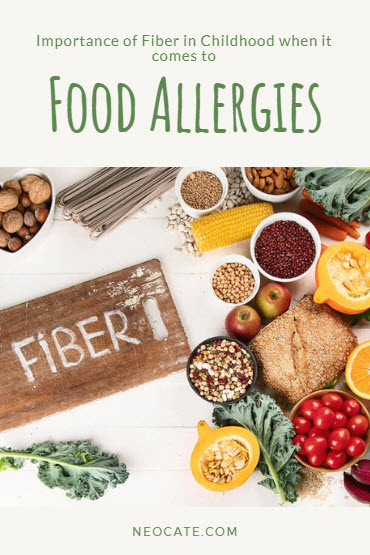What’s the Importance of Fiber? When you hear the term “essential nutrients,” what comes to mind? Maybe it’s vitamins and minerals, like vitamin D and calcium. Maybe you think of key nutrients like good fats, such as omega-3s, or complete proteins our bodies use to build muscles. But did you consider the importance of fiber? That’s right, fiber is a key nutrient! Let’s review what fiber is, how it’s helpful for health, and how much children need. We’ll also talk about fiber for children with food allergies and related conditions.
What is Fiber? What is the importance of Fiber?
Fiber is a short word that describes a lot of different compounds. In general, fiber comes from plant-based foods. Fiber comes in many different forms and is found in a variety of foods. The best food sources of fiber are fruits, vegetables, legumes (like beans, soy, and peanuts), nuts, seeds, and whole grains. Specifically, fiber is a type of complex carbohydrate. Unlike other carbohydrates – think sugars and starches – the human body can’t digest fiber.
Many different compounds qualify as fiber. Here are some fiber terms:
- Total fiber – all fiber in your diet from all sources
- Dietary fiber – the fiber in your diet that comes from foods you consume and that can have health benefits
- Functional fiber – unique fibers, like prebiotics, added to foods for specific benefits
- Soluble – fiber that easily dissolves in water. Examples include gums and pectin. Some soluble fibers pick up water as they pass through the digestive system and form gel substances that may slow digestion. Many soluble fibers are easily broken down in the colon by bacteria.
- Insoluble – fiber that does not dissolve easily in water. Examples include cellulose and lignin. Many insoluble fibers help add “bulk” to stool and may speed up the movement of food and waste through the digestive system.
What does Fiber “Do”?
Fiber passes intact to your large intestine (or colon). That’s because our bodies don’t make enzymes that can break the bonds between sugars that link up to form fiber. It might seem like fiber does not do much, but it actually has several key roles in supporting health.
Among its many key functions, some fibers add bulk to the diet, which may help us feel full, aid digestion and lessen the likelihood of constipation. All of these functions increase the importance of Fiber?
While fiber on its own has no nutritional value, it still impacts health. Because a lot of fiber comes from foods we should consume – fruits, vegetables, beans, whole grains, etc. – it can be hard to tease out exact benefits. However, consuming a balanced diet that includes certain foods that are sources of fiber has been linked to:
- lowering risk for certain cancers
- maintaining cholesterol
- reduced risk of heart disease
- helping control appetite
- keeping bowel movements regular
How can compounds that we can’t digest be so helpful? Some fibers help add bulk and keep stool soft and formed. This can slow digestion and help with regularity and bowel movements. Fiber can also bond to substances such as bile acids, carrying them out of your digestive system to benefit cholesterol levels.
However, many reasons that fiber is so helpful, have to do with the microbes in our guts. You see, while we can’t digest fiber, various microbes can. For example, pre-biotic fibers – a type of soluble fiber – help support beneficial microbes in the gut, which then play roles in the normal function of our bodies. Read more about the human gut microbiota and its various benefits.
How Much Fiber Do We Need?
It’s tough to say how much fiber is the right amount to consume on a daily basis. That’s because “fiber” includes so many different compounds and comes from so many sources. However, zero fiber is definitely not enough!
The goals for the amounts of fiber we should eat daily – outlined by the Institute of Medicine – are based on health outcomes in adults. The main factor in the intake level was a level of fiber linked with lower risk of heart disease. That level is also likely to help support gut health.
The daily fiber goal for everyone over 1 year of age is 14 grams per 1000 calories. Note: this is for healthy individuals. This means if you consume around 2,000 calories a day, you should aim for about 28 grams of fiber. There is no daily fiber goal for healthy infants (below 12 months) because breast milk is the recommended nutrition for infants.
Some researchers have suggested that 14 grams of fiber per 1000 calories might be an excessive goal for young children. Another suggested goal for young children is to consume a number of grams per day equal to their age (in years) plus 5. For an example of this goal, a 3-year-old would target eating 8 (3+5) grams of fiber per day.
How Much Fiber Do We Consume?
According to recent surveys of our eating habits, most Americans do not consume enough fiber. This applies to both adults and children. In fact, most children and teens consume less than half the recommended intake level. For most people, consuming more fiber-rich foods can help meet the daily fiber goal. Another option for adding fiber to one’s diet could be adding a daily fiber supplement. Remember to always check with your healthcare team: registered dietitian nutritionists often promote getting nutrients from a balanced diet before adding supplements.
Children with Food Allergies
 The data for children with food allergies is limited but suggests that well below half consume adequate fiber. Consuming more foods that contain fiber can be difficult when the diet is limited by food allergies. For example, soy, wheat, peanuts and tree nuts are sources of fiber but are also among the most common food allergens. Other grains, legumes, and seeds are also food allergens for many people but are less common allergens. What’s someone with food allergies to do?
The data for children with food allergies is limited but suggests that well below half consume adequate fiber. Consuming more foods that contain fiber can be difficult when the diet is limited by food allergies. For example, soy, wheat, peanuts and tree nuts are sources of fiber but are also among the most common food allergens. Other grains, legumes, and seeds are also food allergens for many people but are less common allergens. What’s someone with food allergies to do?
First, check with the healthcare team to see if the diet is providing enough fiber to meet fiber needs. If not, a supplement may be an option. The healthcare team can consider the source of fiber and whether it poses any risk based on the food allergies. For example, people with a wheat allergy would need a fiber source with no ingredients from wheat. They might also need to avoid related grains like barley, rye, or oat.
For children with food allergies who need a nutritionally complete, hypoallergenic formula, fiber intake can be more of a challenge. Neocate Junior is the only hypoallergenic formula for children that has added prebiotic fiber.
The fiber in Neocate Junior come from the root of the chicory plant and was chosen to be suitable for a hypoallergenic formula. Neocate Junior provides about 1 gram of prebiotic fiber per 8-ounce serving. Stools can be green when using formulas without fiber, but that’s less common with formulas that contain prebiotic fiber like Neocate Junior.
What, you may wonder, are prebiotics? Prebiotics are special types of fiber that support the growth of beneficial microbes in our gut. Prebiotics are different than probiotics: probiotics are like “seeds” we can add to the “lawn” (the microbes in our gut) to fill in gaps, where prebiotic fibers act as food for probiotics, or “fertilizer” to support the growth of the entire lawn.
If your healthcare team recommends a fiber supplement, make sure to ask how much to add and how to start using it. Many clinicians suggest adding fiber to the diet slowly and increasing it gradually instead of adding the full amount all at once from day one. This gives the body time to adjust to the change. Ideally the fiber you consume should also be spread out throughout the day.
What else would you like to know about fiber?
 -Rob McCandlish, RDN
-Rob McCandlish, RDN
About the author: Rob McCandlish is a registered dietitian nutritionist (RDN) who joined the Nutricia team in 2010. Rob has years of experience at Nutricia following food allergy research, working with Neocate products, talking with Neocate families and learning about the science behind Neocate and food allergies. He has two nephews who both used Neocate for their cow milk allergies!






